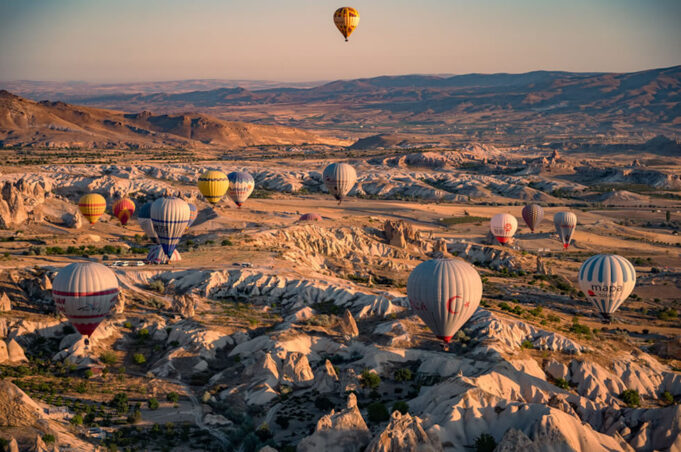Zoë Smith explores the underground dwellings and fairy chimneys of enchanting Cappadocia
This is how the Hittite tribes travelled,” my guide Ibo tells me as we saddle up our horses, a pair of lithe Barb-Arab steeds, stomping their hooves impatiently on the gravel. The Hittites, who inhabited this region of Central Anatolia from as early as 1800 BC, were so renowned for their skilled mounts that the region is named after them. “Cappadocia,” Ibo enlightens me, “means the Land of the Beautiful Horses.”
With its iconic rock spires – evocatively dubbed ‘fairy chimneys’ – set against a tableau of yawning valleys and knobbled peaks, Cappadocia is a land made for exploring on horseback.
We set out from Avanos, a town famed for its distinctive pottery works, and trail the banks of the Kızılırmak, the Red River from which the ubiquitous clay is dredged.
From here, we gallop across grassy steppes blazing with wildflowers and scramble up rocky pathways on foot, our horses clambering nimbly behind. At times we travel almost in silence, the only sound our horses’ hooves clattering over tuff ridges or brushing thickets of lavender; at others we amble through rock-hewn villages where locals shout cordialities or weave our way through throngs of tour buses.
Geological marvels
In the Devrent Valley, or ‘Imagination Valley’, we get the first taste of picture-postcard Cappadocia, a geological marvel formed by volcanic eruptions over 30 million years ago. The other-worldly terrain, shaped and sculpted through years of erosion, is a natural museum, each valley unveiling a gallery of equally spectacular rock art. Here, the peculiar rock formations bear such an uncanny resemblance to animals, that the valley has been nicknamed the ‘sculpture zoo’.
Neighbouring Paşabağ, or Monk’s valley, once sheltered hermit monks in its mushroom-capped fairy chimneys, some towering 20 metres overhead. We trot through the humourously christened ‘Love Valley’, its tuff whipped into curiously phallic peaks, and loop back to Çavusin, where the ruins of an ancient cave settlement are etched into the rock face.
Göreme’s churches are not the only reminder of Cappadocia’s renowned religious tolerance; vast numbers of early Christians sought refuge in the region, leaving behind the greatest concentration of Roman and Byzantine era churches in the country, merging with the unearthly landscape.
The Ihlara Valley, cocooned beneath the now-extinct Hasan and Melendiz volcanoes, envelops some 100 ancient churches in its folds, reached by one of the region’s most idyllic treks. I opt to hike a four-hour stretch, tracing the paths carved into the towering red rock canyon by the swollen Melendiz River– an ideal location for Christian communities to hide from Arab invasion.
Another safe haven was the nearby Derinkuyu, the largest and most visited of the region’s extraordinary underground cities, dating back to 1200 BC and accommodating communities of up to 20,000 people. One of around 40 such settlements excavated in the region brings a whole new meaning to the caveman stereotype: nine storeys burrowing to depths of 55 metres, still aired by the original ventilation shafts and connected by a tangle of narrow tunnels.
The vastness of the underground realm is mind-boggling. In one space, two long, rock-hewn tables indicate a dining room or school; in another, black charred nooks hint at a one-time kitchen. The bottom floor dungeons are accessible by a tunnel so tight I find myself bent double, crawling into the depths of the earth.
Blending ancient and modern
Despite its burgeoning tourism industry, Cappadocia retains a refreshingly mindful ethos, ensuring modern developments blend seamlessly into the age-old landscape. The result is eerily troglodyte – windows poke out of rocky outcrops, spirals of smoke curl up from squat fairy chimneys, and hotel façades are streaked with iron ore pigment.
Bedding down in a cave dwelling is the quintessential Cappadocian experience, and while the tourist hubs of Göreme and Ürgüp are littered with cave hotels, I’ve opted to stay at the majestic Gamirasu Cave Hotel. Located in the traditional Anatolian village of Ayvali, the hotel is one of a new wave championing sustainable tourism, offering unique cultural experiences.
“When you come here, you are not just visiting my village but my home,” Gamirasu’s proprietor Ibrahim enthuses, insisting I join a tour the following day.
It’s harvest time and the rooftops of Ayvali are blanketed in glistening apricots, the sweet scent following us as we wander through the market, visit a traditional wine cave and sip thick Turkish coffee at the local Kahvehane. This is no ordinary tour. A German couple make up our group of three and, accompanied by a guide, we are invited to the home of a local couple, Durmuş and Fatma, to prepare lunch – a series of mezes followed by aside, a dough-like dessert, sweetened with pekmez, boiled grape syrup.
As we layer finger-like börek pastries with soft, crumbly cheese and bake slippery aubergines swollen with spiced bulgur wheat, it’s the start of my calorific love affair with Turkish cuisine.
Bird’s-eye view
On my final morning, I brave the skies for the ultimate view of Cappadocia – watching the sunrise on a hot air balloon flight. Since the first ballooning company opened in 1991, the activity has taken off with such gusto that locals joke, “Everyone who’s anyone in Cappadocia owns a hot air balloon.”
Sunrise flights are so popular that the floating baskets have become a fixture on the dawn skyline – a bobbing congregation of coloured baubles lingering over the horizon. Groggy from the 4am wake-up call, I clamber into the giant basket, squished between a bevy of camera-clutching tourists. I, too, hold my camera aloft, but no amount of amateur photography could do justice to the sunrise.
This is Cappadocia at its most ethereal – the sky smudged with morning mist; rocky outcrops blushing under the first glaze of sun; the air sweet with the scent of thyme rising from the hillocks.
Beneath us, the expanse of fairy chimneys appears like a wave of triumphant fists punching the air, and as we land with a soft thud amid a long-neglected vegetable patch, I can’t help but raise my champagne glass with them.

















